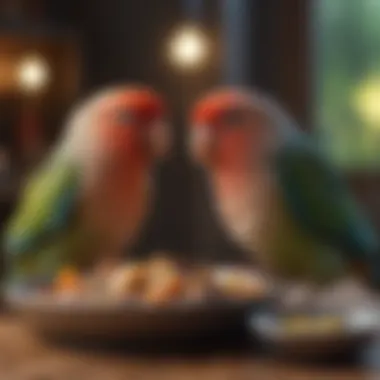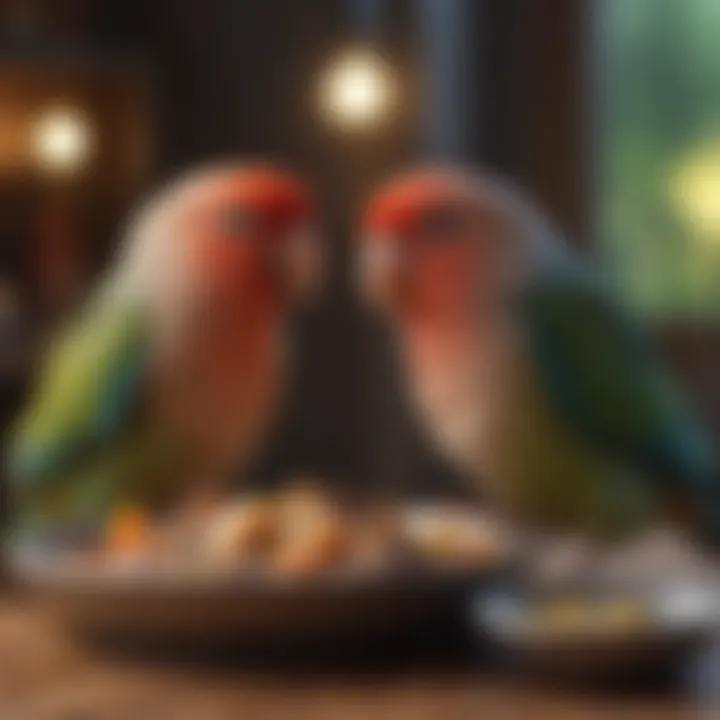The Art of Caring for Lovebirds: A Complete Guide


Intro
Owning lovebirds can be a delightful and rewarding experience, yet it comes with its own unique challenges and responsibilities. These charming little creatures, known for their vivid colors and affectionate nature, require more than just a pretty cage and some seeds. Understanding the nuances of their behavior, nutritional needs, and housing can make all the difference in ensuring they lead a happy life. In this guide, we’ll delve into the essential aspects of lovebird care, from establishing a safe and stimulating environment to observing their social interactions. Whether you are new to the world of aviculture or have raised birds for years, this comprehensive look will offer insights to help refine your approach.
Care Tips
Daily Care Routines
Every day should start with checking on your feathered friends. It’s important to establish a routine that includes fresh food and water.
Lovebirds are quite social, so spending time talking or interacting with them daily fosters a bond.
Here's a simple daily checklist:
- Replace water with fresh water in the morning.
- Provide fresh vegetables or fruits as part of their diet.
- Clean their food and water containers to prevent contamination.
- Spend at least 20-30 mins interacting or letting them out of the cage for exercise.
Cage Setup and Maintenance
Setting up their cage is like creating a small paradise for lovebirds. They thrive in a spacious environment that encourages movement and play. A sturdy, well-ventilated cage with horizontal bars is crucial. If you set up their home correctly, they will feel safe and energetic.
- Use natural materials like wooden perches at varying heights.
- Add toys that promote mental stimulation, like swings and bells.
- Regularly check the condition of the cage and replace worn-out parts. A clean setup also mitigates health risks.
Hygiene and Cleaning Practices
Keeping the cage clean should be on top of the list. Lovebirds have sensitive respiratory systems, and avoiding flash can help. Here’s how to keep things tidy:
- Daily Spot Checks: Remove droppings and uneaten food immediately.
- Weekly Deep Clean: Take everything out and wash the cage with pet-safe cleaners.
- Disinfect: Use water and vinegar solution to wipe down surfaces, ensuring no harsh chemicals are used.
- Ventilation: Make sure the environment is drying out properly to avoid mold or bacteria buildup.
Seasonal Care Adjustments
Different seasons can impact the needs of lovebirds. In summer, keep an eye on temperature and humidity. They can’t handle extreme heat well, so keeping their environment cool is vital. In winter, be mindful of drafts and chilly air.
- Provide cozy spots for them, like untreated wood or craft items that they can snuggle into.
- Ensure the temperature is steady, ideally between 65-80°F.
Behavioral Insights
Understanding Bird Body Language
Lovebirds have a language of their own, often expressing feelings through body language. Little habits can reveal much, considering birds cannot speak. They might fluff themselves up to communicate comfort or need. Understanding these cues improves your interaction:
- Wings held slightly away indicate excitement.
- Biting may stem from feeling threatened or bored, not necessarily aggression.
- Slow blinking can be a sign of affection, almost like them saying "I trust you".
Common Behavioral Issues and Solutions
Every now and then, you might notice some undesirable behavior, like excessive screaming or feather plucking. These often indicate boredom or anxiety. Here are some useful tips to tackle these issues:
- Ensure they have plenty of toys and interaction.
- Avoid prolonged periods in isolation; lovebirds are social.
- Create a varied routine to keep things interesting for them.
Positive Reinforcement Techniques
Training is also an essential aspect of their care. Rewarding good behaviors can create a trusting relationship. Use treats or affection to let them know they’re doing great! Here’s how:
- Use small pieces of their favorite treats to motivate.
- Be consistent with commands and the words you use.
Social Interaction Needs
Lovebirds are naturally social, so they flourish with attention, both from human companions and other birds. Keeping them in pairs is often recommended, as they provide each other companionship. Ensuring they’re well socialized may involve:
- Regularly introducing them to new environments and stimuli.
- Allowing them to observe other birds, if possible.
Nutrition Guides
Essential Diet Components
A balanced diet means a healthy lovebird. Seed mix is a staple, but be sure to mix it with fresh fruits and vegetables. Some essentials include:
- Leafy greens like kale and spinach.
- Fruits like apples and berries, removing any unsafe seeds.
- Pellets specially designed for lovebirds to ensure balanced nutrition.
Safe and Toxic Foods
Not all foods are safe for lovebirds. Some common toxic items include:
- Chocolate can be extremely harmful.
- Avocado can cause severe health problems.
- Caffeine should be avoided entirely.
Supplements and Treats
Every good diet can use a little boost. Look for vitamin supplements suitable for lovebirds. Occasionally, you may provide them with treats like millet sprays, but do so in moderation.
Feeding Strategies for Different Species
If you have multiple lovebird species, like Peach-faced or Fischer's lovebirds, they might need slightly different diets. Research or consult a vet for tailored nutrition plans tailored to their species’ needs.
Wellness and Health


Routine Health Checkups
Regular checkups are a good way to keep your lovebirds healthy. Getting them examined by a vet who specializes in avian care can catch potential issues early.
- Plan for at least one professional checkup per year.
Identifying Symptoms of Illness
Observing your birds closely can help catch any problems early. Symptoms to monitor include:
- Change in appetite or activity level.
- Discharge from eyes or nostrils.
- Any signs of stress or excessive preening.
Preventative Care and Vaccinations
Investing in preventative care can save you money and heartache later. Keep their environment mostly free of harmful substances. Some vaccinations are also available, depending on your area, so discussing this with your vet can be beneficial.
Mental and Emotional Well-being
Don’t forget about their mental health! Lovebirds thrive when they have opportunities to engage in play and exploration. Regular interaction with their owners fosters emotional bonds, which is vital for their happiness.
Enriching Activities
Toys and Playtime Ideas
Invest in quality toys that your lovebirds can safely chew and explore. Rotate them often to keep them interested, and use natural wood and sisal rope. A simple cardboard box can provide hours of entertainment!
Training and Tricks
Try teaching your lovebirds to ‘step up’ onto your finger or whistle short tunes. Use patience, repetition, and rewards to encourage them to learn new tricks.
Outdoor Activities and Interaction
Supervised outings in a secure environment can be delightful. Consider using a bird harness or a decorated tent for birds to explore safely.
DIY Projects for Mental Stimulation
Crafting your own toys using paper and natural materials can be a fun way to engage with your lovebirds. Simple projects can help stimulate their minds and keep them entertained. For instance, creating a foraging toy by hiding treats in a box filled with shredded paper.
Remember: The key to a loving relationship with your lovebirds lies in understanding their needs, providing a safe environment, and nourishing their spirits.**
Understanding Lovebirds
When stepping into the world of pet ownership, especially with lovebirds, understanding these vibrant creatures is crucial. Lovebirds are not just pets; they're social beings who thrive on interaction, both with their owners and each other. Comprehending their behavior, needs, and origins lays the foundation for a rewarding and enriching experience.
Origin and Habitat
Lovebirds hail from the warm climates of Africa, primarily found in countries like Madagascar, Angola, and Tanzania. Their natural habitat is a composite of savannahs and woodlands, where they can nest in tree hollows and fly freely among their peers.
Understanding the origins of lovebirds helps us appreciate their behavioral patterns. For instance, in the wild, lovebirds forage for seeds, fruits, and blossoms, and they're adept at socializing in flocks. This innate social behavior makes them longing for companionship. Hence, when adopting lovebirds, potential owners must consider these aspects.
Creating a suitable environment mimicking their natural habitat could vastly improve their wellbeing. A spacious cage, equipped with plenty of toys and perches, can recreate the feel of the treetops where they would normally dwell. Regular exposure to sunlight and fresh air can foster a lively and healthy lovebird, closely resembling their natural habitat.
Species Variations
Lovebirds come in several species, each with unique characteristics and personalities. The most common among them include the Peach-faced lovebird, Fischer's lovebird, and the Masked lovebird. Their colors can range from vibrant greens and yellows to stunning blues and browns, tailoring to every owner’s aesthetic taste.
- Peach-faced Lovebird: Known for their affectionate and playful nature. They adapt well to a domestic environment, making them excellent companions.
- Fischer's Lovebird: They exhibit a slightly more timid demeanor but are equally charming. Their colorful plumage can captivate any onlooker.
- Masked Lovebird: Distinctive for their masked appearance, they possess a spirited character. They can be more vocal than others, often expressing their desires through chirps.
When choosing a lovebird, it’s essential to consider these species variations. Different species may have distinct care requirements and social tendencies, which can impact the owner's experience. The fascinating diversity among lovebirds can also influence how they interact with fellow pets and their environment, enriching the owner’s understanding.
"Understanding the origin and species variations of lovebirds is key to nurturing them effectively and ensuring a fulfilling relationship."
In essence, diving into the intricacies of lovebirds—where they come from and the different types available—enables pet bird owners to set the stage for a happy and harmonious living arrangement.
Choosing the Right Lovebird
Choosing the right lovebird is pivotal for successful ownership. These charming companions bring joy and vibrancy into any home, but not all lovebirds fit every lifestyle or owner. Making the right choice can lead to a long, happy relationship that flourishes. Lovebirds are social creatures, and each one has its unique personality, preferences, and potential health quirks. Therefore, whether you are a seasoned bird owner or new to the scene, understanding how to select the perfect lovebird is essential.
Temperament and Personality
When it comes to lovebirds, temperament plays a huge role in how well they fit into your home. Each lovebird boasts its personality, which can range from extroverted and playful to shy and reserved. Before you commit, consider the following:
- Interaction Style: Some lovebirds enjoy cuddling and being handled, while others might be more independent or reserved in their interactions. Take time to observe how different birds respond to people.
- Social Dynamics: If you're interested in adopting more than one, remember that not all lovebirds will get along. They can be territorial, especially if pushed together too quickly. Choose birds that have been raised in a social environment or have a history of compatibility.
- Energy Levels: Different species have different energy levels. Some might zoom around and stay active, while others are more relaxed and enjoy sitting in their cages.
You can gauge temperament by visiting a shelter or breeder. Spend time with the birds and pay attention to how they interact with you and each other to find the perfect match.
Health Considerations
Health checks are a necessary part of the lovebird owning process that can help you identify potential issues before they snowball into serious problems. Not only do healthy lovebirds thrive, but they also bring peace of mind to their owners. Here’s what to keep in mind:


- Physical Appearance: Look for vibrant feathers, a clean beak, bright eyes, and an active demeanor. Any signs of dull or missing feathers can indicate underlying health issues.
- Behavioral Signs: Look out for changes in feeding habits or unusual lethargy. A lovebird that suddenly seems less active might be unwell.
- Veterinary Check-ups: Establishing a relationship with an avian veterinarian ensures regular health screenings and vaccinations, which are crucial for early illness detection.
"A healthy lovebird not only lives longer but also promotes a joyful and engaging home atmosphere."
In summary, the journey of picking a lovebird involves careful consideration of temperament and health. Each bird is as unique as its owner, and understanding these nuances helps ensure a harmonious environment for both pet and owner.
Creating the Ideal Environment
Creating a loving and healthy environment for lovebirds is fundamental. These birds are inherently social creatures and flourish when provided with the right habitat. An ideal environment goes beyond just cage specifications; it involves understanding their behaviors and preferences as well. When you prioritize their surroundings, you contribute to their overall well-being, happiness, and health. By ensuring their space meets their needs, you pave the way for a more nurturing relationship.
Cage Selection
Choosing the right cage is crucial. A cage should be spacious enough for lovebirds to move around freely, flapping their wings without restriction. A cage that is too small can lead to stress and make them more prone to health issues. Look for a cage that's at least 24 inches wide and 36 inches tall. Ensure the bars are close enough together to prevent escapes, particularly with younger birds who tend to be curious.
Key Considerations:
- Material: Opt for non-toxic metal as lovebirds are known to chew on everything they find. Avoid plastic or painted surfaces.
- Entrance Size: Larger doors allow easier access for both cleaning and interacting with your birds.
- Bottom Design: A removable tray simplifies cleanup and helps in maintaining hygiene.
Environmental Enrichment
To keep lovebirds mentally stimulated, environmental enrichment is essential. This aspect involves creating a space where they can explore, play, and engage with their surroundings. Integrating elements of fun and discovery into their habitat encourages both physical and mental exercise.
Feeding stations
Feeding stations play a pivotal role in keeping lovebirds mentally active. These areas should be varied and placed in different locations within the cage. This encourages movement, letting your birds work for their meals and engage in a more natural behavior.
- Key Characteristics: Multiple feeding spots can prevent territorial disputes and boredom.
- Unique Features: Consider using different types of feeders (suspended, dish-type, etc.) that allow them to forage. This not only keeps them engaged but helps in mimicking their natural foraging instincts.
Perches and toys
Perches and toys are not merely decorative elements in the cage; they are vital components of any lovebird’s environment. Lovebirds enjoy hopping and climbing, so having them at various heights is beneficial.
- Key Characteristic: Choose perches made from natural wood. This provides different textures and sizes, promoting foot health.
- Unique Feature: Include toys that encourage chewing and pulling. This not only keeps their beaks healthy but also promotes playfulness.
Natural light requirements
Natural light is another important aspect. Lovebirds require proper light exposure to maintain their circadian rhythms. This is fundamental for their mental health and overall well-being.
- Key Characteristic: Placing the cage in a well-lit area can help mimic their natural habitat, enhancing their mood and activity levels. However, be sure to avoid direct sunlight that could overheat the cage.
- Unique Feature: Utilize daylight-spectrum bulbs if natural light exposure is limited. They can help in replicating sunlight’s effects and positively influence your birds’ behavior.
Nutritional Needs
Nutritional needs form the bedrock of a lovebird's health and overall wellbeing. Just like humans don't thrive on junk food, lovebirds require a balanced diet to maintain not only their physical health but also their vibrant personalities. A well-fed lovebird showcases a glossy plumage, robust energy, and a lively demeanor, which speaks volumes about the care they receive. Ignoring their nutritional requirements can lead to lethargy, illness, and even serious health conditions.
Essential Diet Components
When setting up a diet for lovebirds, one needs to consider a variety of foods that cater to their specific needs. Here are the primary components that should be included:
- High-Quality Pellets: This serves as the mainstay of their diet. Pellets are formulated to provide a balanced intake of vitamins, minerals, and protein. Not all pellets are made equal, so it is important to choose a reputable brand.
- Seeds: While seeds can be a favorite, they should be offered in moderation due to their high-fat content. A good seed mix appropriate for lovebirds often includes millet, canary seeds, and other small seeds.
- Fruits and Vegetables: Incorporating fresh produce is crucial. Examples include leafy greens like kale and romaine, carrots, bell peppers, and berries. These not only provide vital nutrients but also keep the feeding process stimulating.
- Grains and Nuts: A moderate amount of cooked whole grains such as quinoa, brown rice, and rolled oats can contribute to their diet. Nuts, though calorie-rich, can offer beneficial fats and should be given occasionally.
Mixing these items in their daily meals can create a buffet that keeps your lovebird both satisfied and healthy.
Common Feeding Mistakes
Even seasoned bird owners can stumble when it comes to feeding their feathered friends. Below are some prevalent pitfalls and how to sidestep them:
- Over-Reliance on Seeds: Several owners think seeds are all that lovebirds need. This can lead to malnutrition. It’s crucial to balance seeds with pellets and fresh foods.
- Neglecting Variety: Feeding the same foods every day can bore your bird and miss out on crucial nutrients. Variety is the spice of life—even for lovebirds!
- Leaving Spoiled Food: Like humans, birds can get sick from spoiled or moldy food. Regularly check for freshness and preen their diet of anything past its prime.
- Ignoring Water Needs: Birds often drink less when on a seed-based diet. Always provide clean and fresh water daily, as staying hydrated is vital for their overall health.
"A balanced diet can mean the difference between a chirpy companion and a sickly pet."
Caring for a lovebird means understanding their unique nutritional needs, setting them up for a long, healthy, and happy life alongside you.
Behavioral Insights
Understanding the behavioral patterns of lovebirds is crucial for any aspiring or current pet owner. These vibrant creatures have unique social structures and personalities, which can significantly affect their well-being and your experience as an owner. By recognizing how these birds interact both with each other and with their human companions, you can create a more fulfilling environment that caters to their emotional needs.
Social Interactions
Lovebirds are innately social animals. They thrive on companionship, which is a core aspect of their nature. In the wild, they often form strong bonds within their flocks. This high level of sociality is something that needs to be mimicked at home.
- Bonding with Your Lovebird: Establishing a connection with your feathered friend is essential. Spend time talking to them, offering treats, and, if possible, allowing them to interact with other birds. This way, they receive both your companionship and the social interactions they crave.
- Pairing Up: If possible, consider adopting a pair. Lovebirds generally do better with companions. Whether it’s another lovebird or a human, having someone around can alleviate loneliness and behavioral issues that arise from isolation.
- Observing Body Language: Pay attention to your pet's body language. For instance, if a lovebird fluffs up, it often indicates comfort and contentment, while a stiff stance can suggest they are agitated or upset. Learning these signals will enhance your relationship and help prevent misunderstandings.
Stress Indicators
Stress can severely affect a lovebird’s health and behavior. It's vital to recognize the signs of distress to respond appropriately and create a safe space for your bird.
- Common Signs of Stress: A few indicators include excessive chatter, feather plucking, and even aggressive behaviors towards their environment or fellow birds. If you notice your lovebird behaving out of character, it can signify that something is amiss. An important thing to note is that stress can be a result of various factors, including changes in routine, environmental shifts, or health issues.
- Creating a Calm Environment: Make sure their housing situation is stable. A cluttered cage, drastic temperature changes, or loud noises can all contribute to a lovebird's stress levels. Slow transitions to new settings or introducing new toys cautiously can go a long way in minimizing anxiety.
- Regular Monitoring: Regularly observing your lovebird allows you to catch these stress indicators early before they escalate into bigger issues. A daily check can help establish their normal patterns and behaviors, aiding in detecting any sudden changes.
Emotional well-being is just as important for birds as it is for humans. Always listen to their needs and adjust your approach accordingly.


In summary, understanding and addressing the social interaction and stress indicators of your lovebird can substantially improve their quality of life. Nurturing these aspects leads not only to a happier bird but also to a more fulfilling relationship between you and your avian companion.
Health and Wellness
When it comes to owning lovebirds, understanding their health and wellness is not just an option—it's a necessity. These vibrant, sociable creatures thrive in environments where their health needs are met, and their spirits are cared for thoughtfully. This section will venture into regular health check-ups and identifying common illnesses, emphasizing how proactive attention can enrich a lovebird's life and deepen the bond between birds and their humans.
Regular Health Check-ups
Routine health examinations are the bedrock of maintaining your lovebird's vitality. Scheduling regular vet visits ensures that any potential health issues are caught early, which is crucial for species that might not readily show signs of distress. Here are some critical aspects to consider:
- Frequency of Check-ups: For young lovebirds, a check-up every six months is advisable. For older birds or those with known health issues, quarterly visits might be more prudent.
- Veterinary Expertise: Seek avian veterinarians, as they have specialized knowledge about birds. Not all vets have the expertise to treat these unique pets.
- Preventive Care: During check-ups, routine tests for parasites and other common ailments should be conducted. This might include using fecal tests to monitor intestinal health.
- Vaccinations and Treatments: Staying up to date with vaccinations is a must. Discuss preventive treatments such as those for worms or mites with your vet.
Regular check-ups can be likened to tuning up a well-loved car; minor adjustments and inspections can prevent significant breakdowns down the road.
Identifying Common Illnesses
Understanding common illnesses is invaluable for any lovebird owner. Knowledge of symptoms can drastically improve the outcome of illnesses that might otherwise go unnoticed. Here’s a glimpse into some prevalent issues:
- Respiratory Infections: Symptoms like wheezing, nasal discharge, or labored breathing can indicate respiratory illness. These conditions can quickly worsen if not treated immediately.
- Psittacosis: This bacterial infection is often characterized by lethargy, loss of appetite, and abnormal droppings. Early detection is key, as this can be contagious to humans.
- Feather Plucking: While not an illness in itself, feather plucking can be a sign of stress or illness. It's critical to determine the underlying cause to effectively address this behavior.
- Gastrointestinal Issues: Diarrhea or changes in droppings can signal dietary issues or infections. Monitoring feeding habits closely is important for early identification.
"A healthy lovebird brings joy and companionship; a sick one brings worry. Stay on top of their health, and you will not only prevent disease but also foster a stronger bond."
Breeding and Nesting
Breeding and nesting play a crucial role in understanding lovebird ownership. These activities not only reflect the birds' natural instincts but also establish a deeper bond between the owner and the pets. Recognizing the breeding behavior and providing the right nesting environment can lead to healthier birds that thrive in a homely atmosphere. Here we delve into the specifics, including the patterns of breeding behavior and essential nesting requirements.
Breeding Behavior
When lovebirds enter breeding season, their behavior shifts noticeably. This time, they become more vocal and display heightened activity. The males often engage in courtship dances, showcasing their vibrant plumage and lively hops to impress the females. Such behavior is significant as it highlights the natural instincts of these birds, reinforcing their identity as social creatures.
Understanding these nuances is key for bird parents. Since lovebirds are monogamous, it is preferred to house them with a partner. This companionship leads to less stress and promotes natural interactions during breeding. Watchful owners may notice these behaviors:
- Increased Restlessness: Birds may become more energetic, hopping around their environment.
- Beak Preening: Partners often engage in mutual preening, a sign of affection and care.
- Aggressive Displays: During courtship, some males might show aggression to protect their potential mate, which is a normal part of their breeding ritual.
Establishing an appropriate environment helps ensure successful breeding. Keep in mind that stress factors, such as loud noises or the presence of predators, can disrupt this delicate process. Providing a peaceful and safe atmosphere fosters successful breeding and contributes to a happier, more stable life for the lovebirds.
Nesting Requirements
Creating an ideal nesting space is paramount for breeding lovebirds. These birds need a place where they can feel secure and comfortable. Here are essential elements to consider:
- Nest Box Size: Use a nesting box measuring around 8x8x12 inches. This size balances enough room for movement with a cozy setting. A larger box might not provide the enclosed feeling they prefer.
- Material: Opt for wood or untreated plywood for the nesting box. Avoid metal as it can become too hot or cold, impacting the eggs and birds.
- Nesting Material: Fill the box with a mixture of soft materials such as shredded paper, hay, or coconut fibers. This encourages warmth and comfort for the eggs and chicks.
- Location: Position the nesting box in a quiet corner of their cage, away from light and disturbances. Lovebirds prefer places where they can watch their surroundings while feeling secure.
- Temperature Control: Keep the temperature stable. Lovebirds thrive in conditions between 70 and 80 degrees Fahrenheit. Sudden temperature fluctuations can stress the birds and affect breeding success.
"A cozy nest is the heart of a successful breeding environment. It's more than just a box; it’s a sanctuary."
By catering to these nesting requirements and supporting natural breeding behaviors, you create a nurturing environment that encourages your lovebirds to flourish. Understanding these practices is not just about breeding; it's about cultivating a respectful relationship with your feathered companions.
Rescue and Adoption
Rescue and adoption of lovebirds is a vital subject that deserves the attention of any prospective or existing bird owner. Many birds end up in shelters or are given away due to various unforeseen circumstances, such as lifestyle changes or a lack of knowledge on how to care for them. Choosing to adopt not only gives a loving home to a needy bird, but it also has numerous benefits for the owner. When you rescue a lovebird, you’re not just saving a life; you’re also gaining a companion that is often full of personality and affection.
Adopting can often come with a backstory that sheds light on the lovebird's past experiences, both positive and negative. Understanding these histories is crucial for setting the stage for a successful integration into your home. Each lovebird carries traits influenced by its previous environments, which can manifest in behaviors ranging from endearing to a little challenging.
"Nothing adds more beauty to life than someone who is living their life in their own way."
Not only does adopting save lives, but it also helps combat the issues of unethical breeding and pet shops. Many people are unaware of the darker side of the pet trade and how certain birds may suffer from poor breeding practices. By choosing to adopt, you’re making a stand against these practices.
Understanding Rescue Organizations
Rescue organizations play a critical role in the lovebird adoption process. These entities prioritize animal welfare and take in lovebirds that are surrendered or abandoned. Such organizations often work tirelessly to rehabilitate these birds, providing them with medical care, socialization, and training. Furthermore, the personnel often possess an array of experience and knowledge about avian behavior that can be invaluable to prospective owners.
For those looking to adopt, finding a reputable rescue organization involves some research. Consider reaching out to local shelters, bird sanctuaries, and avian rescue groups. Websites like reddit often have community threads where you can connect with individuals who are experienced in lovebird adoption. Some notable organizations include the American Birding Association and Birds of a Feather.
Transitioning into a New Home
Once you’ve decided to bring a lovebird into your life through rescue, the next step involves a smooth transition into their new home. This period can be quite stressful for the bird, so how you approach it matters greatly.
- Create a Comfortable Space: Before bringing your new friend home, ensure that their space is welcoming. Remove any hazards, set up their cage, and include familiar items like toys or a perch from their previous environment, if possible.
- Gradual Introduction: When introducing your lovebird to their new surroundings, allow them to explore gradually. Limit human interaction at first, as they may need time to adjust.
- Observation: Pay attention to their behavior. Take notes on how they respond to different stimuli in your home. It can help you understand their preferences and needs.
- Establish a Routine: Birds thrive on routine. Feed them at the same time daily and set specific playtimes to build trust between you.
- Stay Patient: Not every lovebird will adapt at the same pace. Offering constant encouragement and gradual affection can make all the difference.
By adopting a rescue lovebird, you are not just shadowing a creature’s journey; you are also embarking on your own, filled with joy, responsibility, and immeasurable love. It’s a venture that echoes with significance—one where both you and your feathered companion will grow together in a nurturing environment.
The End
When it comes to owning lovebirds, understanding their unique needs and behaviors is paramount. This article has unraveled various dimensions of lovebird ownership, making it clear that these charming creatures require more than just a shelter and food.
Through thoughtful care and attention, lovebirds can flourish, offering companionship and joy to their owners.
Summarizing Key Points
Highlighting some essential elements discussed:
- Origin and Habitat: Lovebirds hail from Africa, thriving in diverse environments that affect their social structures and behavior.
- Choosing the Right Lovebird: Understanding temperament helps in selecting a bird that matches your lifestyle. Not all lovebirds are alike; some are more social, while others prefer solitary activities.
- Creating the Ideal Environment: A well-chosen cage coupled with stimulating toys and natural light can greatly enhance their quality of life.
- Nutritional Needs: A balanced diet is not just about seeds. It includes fresh fruits, vegetables, and proper supplements to keep them healthy.
- Behavioral Insights: Recognizing stress indicators early can prevent bigger health troubles.
- Health and Wellness: Regular check-ups are indispensable for catching any issues before they escalate.
- Rescue and Adoption: The importance of giving a second chance to lovebirds in need cannot be overstated.
The combination of these insights presents a holistic view of what it means to own lovebirds. Remember, they’re not just pets; they’re companions who deserve a nurturing environment.
Encouragement for Responsible Ownership
With the key points outlined, it’s crucial to encourage responsible ownership. Lovebirds are sociable beings typically living in flocks in the wild. Therefore, bringing one into your home means recognizing your role in their life. This responsibility includes:
- Commitment: Owning a lovebird isn't a fleeting decision. They could live for over ten years; you need to be ready for the long haul.
- Education: Continuously learn about their needs and behaviors even after bringing them home. Up-to-date knowledge about their care can yield a happier pet.
- Connection: Spend quality time with your lovebirds. They thrive on interaction and require daily engagement to stay emotionally and socially healthy.















